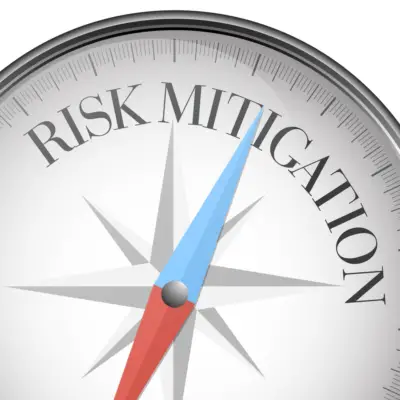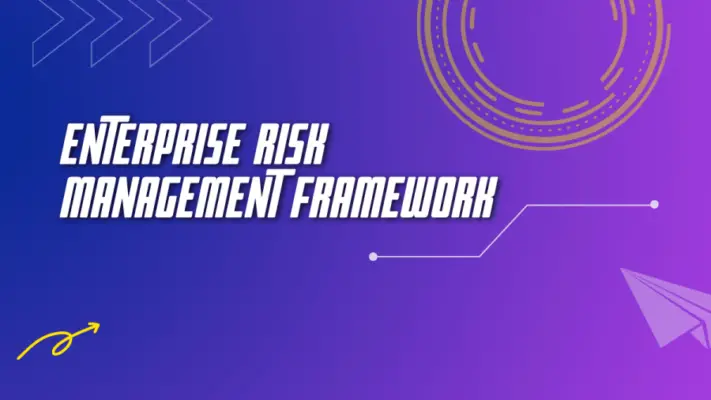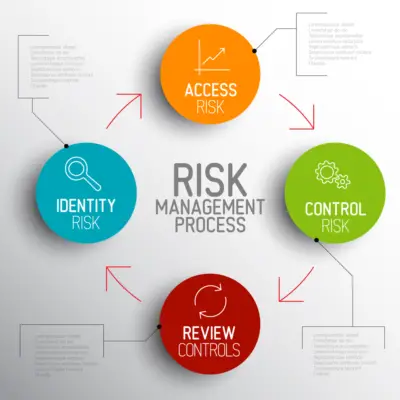Risk and Control Self-Assessment (RCSA) is a structured approach used by businesses to manage their operational and business risks.
It is a methodology that involves identifying, assessing, mitigating, and monitoring risks across all levels of an organization.
RCSA is commonly used by banks and financial institutions as well as by companies to identify and assess operational risks that may threaten business goals.
Implementing an RCSA process in a business can provide several benefits. The first benefit is that it helps businesses identify risks and assess risks in a structured and systematic manner.
Identifying and assessing risks, businesses can develop effective strategies to mitigate and manage risks, which can help protect the business from financial losses and reputational damage.
The second benefit of RCSA is that it helps businesses to improve their control environment. By assessing the effectiveness of organizational control measures in managing risks, businesses can identify areas where controls can be improved to mitigate risks.

Comprehensive Risk Mitigation: A Risk Mitigation Plan Might Include
This can help businesses to reduce the likelihood of errors, fraud, and other risks that can impact the organization. Additionally, it can help businesses to comply with regulatory requirements and industry standards.
Understanding RCSA in Business
Risk and Control Self-Assessment (RCSA) is a process used by organizations to identify, assess, and manage risks in their business units.
It is a critical component of enterprise risk management and regulatory compliance, as it helps businesses to identify potential risks and take necessary corrective actions to to mitigate them.
The RCSA process involves a systematic approach to identify and evaluate risks associated with business units. This process involves the identification of risks and controls, the assessment of their effectiveness, and the development of an action plan to both key risk indicators address any gaps.
One of the main benefits of RCSA is that it provides an environment for management and employees to work together to identify and manage risks. By involving employees in the process, the organization can gain a better understanding of the risks associated with their operations and develop effective, risk identification and management strategies.
Another benefit of RCSA is that it can help businesses to comply with regulatory requirements. By identifying and mitigating risks, organizations can demonstrate to regulators that they are taking the necessary steps to comply with regulations.
Moreover, the RCSA process can help businesses to improve their overall risk management practices. By identifying and mitigating risks, organizations can reduce the likelihood of losses and improve their ability to achieve their business objectives.
Lastly, the process can help businesses to increase their operational efficiency. By identifying and addressing gaps in their risk management practices, organizations can improve their overall performance and reduce the likelihood of operational disruptions.
The process is a critical component of enterprise risk management and regulatory compliance. It helps businesses to identify and manage risks associated with their business units, comply with regulatory requirements, improve their risk management practices, and increase their operational efficiency.
The RCSA Process: Steps and Techniques
The Risk and Control Self-Assessment (RCSA) process is a crucial component of operational risk management in any business. It involves identifying, assessing, and mitigating risks associated with business processes, products, and services.
The RCSA process is an ongoing activity that helps in managing risks effectively by evaluating the effectiveness of controls and monitoring the risk profile of the organization.
The process typically involves four key components: Identification, Assessment of Risks, Risk Mitigation, and Risk Monitoring.
The first step in the process is identifying potential risks that could affect the organization and its business objectives. This can be done through various methods, such as workshops and interviews with key stakeholders.
Once the risks have been identified, the next step is to assess them. This involves evaluating the likelihood and impact of each risk and determining its inherent risk level. Inherent risks are those that exist without any controls in place.
After assessing the risks, the next step is to develop risk mitigation strategies. This involves further risk assessments and developing action plans to reduce the likelihood or impact of the identified risks.
The business processes are reviewed, and a control environment is established to manage the residual risk. Key Risk Indicators (KRIs) are also established to monitor the effectiveness of the mitigation strategies.
It is also used to evaluate the effectiveness of the existing controls and identify areas where improvements are needed. This helps in developing a risk-aware culture in the organization. The process also helps in meeting regulatory requirements and ensuring business continuity.
The implementation of the process requires the involvement of a cross-functional team, including the risk manager, business process owners, and other key stakeholders.
Effective communication is also crucial to ensure that the process is understood and followed by everyone in the organization.
The RCSA process is an efficient and effective way of managing business risks. It helps in identifying potential risks, assessing their likelihood and impact, and developing mitigation strategies to reduce their impact.
The process also helps in monitoring the effectiveness of controls and ensuring compliance with regulatory requirements. Businesses can develop a risk-aware culture and manage their risks more effectively.
Key Benefits of Implementing RCSA
The Risk and Control Self-Assessment (RCSA) process is an effective tool that businesses use to identify, assess, mitigate, and monitor risks.
Implementing RCSA in a business can offer numerous benefits that can add value to the organization. Here are some of the key benefits of implementing RCSA:
1. Improved Efficiency and Effectiveness
RCSA helps businesses to identify and prioritize risks, which enables them to allocate their resources more efficiently. By identifying the most significant risks, businesses can focus on implementing effective controls to mitigate those risks.
This approach can lead to more efficient and effective risk management practices, which can ultimately improve the overall performance of the organization.
2. Relevance to Business Objectives
RCSA is a process that is tailored to the specific needs of each business. As such, it is designed to be relevant to the business objectives of the organization.
Through aligning the process with the business’ strategic objectives, businesses can ensure that they are addressing the risks that are most critical to their success.
This approach can help businesses to achieve their goals and objectives more effectively.
3. Greater Value for the Organization
The RCSA process provides businesses with a comprehensive understanding of their risk profile. This understanding can help businesses make informed decisions about their risk management strategies, which can add value to the organization.
In identifying and mitigating risks, businesses can protect their assets, reputation, and stakeholders. This approach can help businesses to create long-term value for their organization.
4. Continuous Improvements
RCSA is a process that is designed to be of continuous improvement. As such, it enables businesses to continuously monitor and improve their risk management practices. Regularly reviewing and updating the process, businesses can ensure that they are addressing the most significant risks and implementing the most effective controls.
This approach can help businesses stay ahead of emerging risks and maintain a competitive advantage.
Implementing the process in a business can offer numerous benefits, including improved efficiency and effectiveness, relevance to business objectives, greater value for the organization, and continuous improvements.
On leveraging these benefits, businesses can create a robust risk management framework that can help them to achieve their goals and objectives.

Role of Different Stakeholders in RCSA
The Risk and Control Self-Assessment (RCSA) process involves various stakeholders in the organization. The stakeholders play different roles in the process, and their participation is essential for the success of the process.
Stakeholders
Stakeholders are individuals or groups with an interest or stake in the organization’s performance. In the RCSA process, stakeholders include employees, managers, and executives.
They are responsible for quantitative risk assessments identifying risks, assessing controls, and implementing action plans to mitigate risks.
Business Objectives
Business objectives are the goals that an organization aims to achieve. The process helps risk managers to align the organization’s risk management activities with its business objectives.
In identifying risks that could impact the achievement of business objectives, the organization can take proactive measures to manage those risks.
Board
The board of directors is responsible for overseeing the organization’s risk management activities. The RCSA process provides the board with a comprehensive view of the organization’s risk profile, enabling them to make informed decisions about risk management.
Risk Manager
The risk manager is responsible for the managing risks in the process. They coordinate the activities of different stakeholders and ensure that the process is carried out effectively.
The risk manager also provides guidance and support to stakeholders throughout the process.
External Auditors
External auditors are independent professionals who assess the organization’s financial statements and internal controls.
The RCSA process provides external auditors with valuable insights into the organization’s risk management activities, enabling them to provide an objective risk assessment because of the organization’s internal controls.
Service Providers
Service providers are third-party vendors who provide services to the organization. The RCSA process helps to identify risks associated with service providers and ensure that adequate controls are in place to manage those risks.
The process involves various stakeholders who play different roles in the process. By working together, stakeholders can effectively manage risks and align risk management activities with the organization’s business objectives.
Risk and Control Self-Assessment (RCSA) is a critical tool for managing operational risk in an organization. It helps to identify, assess, and mitigate risk exposure to the potential sources of loss or harm that could affect the business objectives.
RCSA is also an essential tool for governance and compliance.
Governance is the process of establishing policies, procedures, and controls to ensure that the organization operates effectively and efficiently.
It Helps to identify the risks that could impact the governance of the organization and provides a framework for managing those risks. It also helps to ensure that the organization’s risk appetite is aligned with its business objectives.
Compliance is the process of ensuring that the organization complies with the laws, regulations, and policies that apply to it.
RCSA helps to identify the risks that could impact regulatory compliance and provides a framework for managing those risks. It also helps to ensure that the control environment is effective in mitigating those risks.
It provides a structured approach to identify, assess, and mitigate risks that could impact governance and compliance.
It helps to ensure that the organization has a sound system for managing operational risks and provides assurance to the governing body and regulators that the organization is managing its risks effectively.
It is a critical tool for managing operational risk in an organization. It helps to identify, assess, and mitigate risks that could impact governance positive risk culture and compliance.
RCSA provides a structured approach to managing risks and helps ensure the organization has a sound system for managing operational risks.
RCSA and Operational Risk Management
Risk Control Self-Assessment (RCSA) is a methodology used by businesses to manage their and identify operational risks, risk and business risks.
It is a structured approach that involves identifying, assessing, mitigating, and monitoring risks across all levels of an organization.
It can play an important function by raising awareness of operational risk within the organization and improving the company’s risk culture. It can also support governance and compliance, as well as reinforce the efforts of internal and external auditors.
Operational risk management is the process of identifying, assessing, and controlling risks arising from the people, processes, and systems that support an organization’s activities.
Operational risk is the risk of loss resulting from inadequate or failed internal processes, people, and systems, or from external events.
RCSA can help organizations manage their operational risk by providing a systematic approach to identifying and assessing risks, evaluating the effectiveness of controls, and monitoring risk profiles over time.
RCSA is an essential component of a comprehensive operational risk management program. It helps organizations identify and assess risks, develop risk profiles, and establish risk mitigation strategies.
Conducting these regularly, organizations can maintain an up-to-date understanding of their risk landscape and residual risk. This enables them to make informed decisions about business continuity, risk management, and risk mitigation strategies.
RCSA is a critical component of effective operational risk management. It helps organizations identify and assess risks, develop risk profiles, and establish risk mitigation strategies.
Conducting RCSAs regularly, organizations can maintain an up-to-date understanding of their risk landscape and residual risk. This enables them to make informed decisions about business continuity, risk management, and risk mitigation strategies.
RCSA in Financial Institutions
The Risk Control Self-Assessment (RCSA) process has become an essential tool for financial institutions to identify, evaluate, and manage operational risks. The process involves a systematic approach to identify potential risks, assess their impact, and develop controls to mitigate them.
Financial institutions such as banks, insurance companies, and investment firms are required to comply with regulatory requirements and maintain a robust risk management framework.
The RCSA process helps these institutions to comply with regulatory requirements and strengthen their risk culture.
According to the Central Intelligence Agency (CIA), financial institutions are vulnerable to a range of operational risks, including fraud, cyber-attacks, and non-compliance with regulations.
The RCSA process helps financial institutions to take risk appetite, identify these risks and develop controls to mitigate them.
One of the benefits of the RCSA process in financial institutions is that it helps to create a culture of risk management. By involving employees in the process of identifying and assessing risks, financial institutions can raise awareness of potential risks and build a risk-aware culture
The RCSA process also helps financial institutions to improve their operational efficiency. By identifying and mitigating potential risks, financial institutions can streamline their processes and reduce the likelihood of errors and operational failures.
In conclusion, the RCSA process is an essential tool for financial institutions to manage operational risks and comply with regulatory requirements.
Creating a culture of risk management and improving operational efficiency, financial institutions can mitigate potential risks and improve their overall performance.
What is RCSA, and how is it used in business?
RCSA stands for Risk and Control Self-Assessment. It is a process used by businesses to identify, assess, and manage operational risks.
RCSA involves evaluating the effectiveness of existing controls and identifying areas where additional controls may be necessary. Business unit managers and risk management professionals typically conduct the process.
How does RCSA help businesses manage operational risk?
RCSA helps businesses manage operational risk by providing a structured approach to identifying and assessing risks.
Conducting an RCSA, businesses can identify potential sources of loss or harm and take steps to mitigate those risks. The process also helps businesses to see control weaknesses and identify areas where additional controls may be necessary to manage risk effectively.
What are the key benefits of implementing an RCSA process?
The key benefits of implementing an RCSA process include improved risk management, increased transparency, and enhanced compliance.
Conducting an RCSA, businesses can identify potential risks and take steps to mitigate those risks. The process also helps to improve transparency by providing a clear view of the risks faced by the organization.
Finally, RCSA can help businesses comply with regulatory requirements by ensuring that appropriate controls are in place.
How does RCSA support compliance with regulatory requirements?
RCSA supports compliance with regulatory requirements by ensuring that appropriate controls are in place to manage operational risks.
Conducting an RCSA, businesses can identify potential risks and take steps to mitigate those risks. This helps to ensure that the organization is complying with regulatory requirements and avoiding potential fines or penalties.

Unpacking the RCSA Process
What are some best practices for conducting an effective RCSA?
Some best practices for conducting an effective RCSA include involving all relevant stakeholders, using a standardized approach, and ensuring that the process is well-documented.
It is also important to ensure that the RCSA is conducted regularly and that the results are communicated to all relevant stakeholders.
How can RCSA be integrated into a broader risk management framework?
RCSA can be integrated into a broader risk management framework by aligning the process with the organization’s overall risk management strategy.
This involves identifying the key risks faced by the organization and ensuring that the RCSA process is designed to address those risks.
RCSA can also be integrated with other risk management processes, such as incident management and business continuity planning.

Chris Ekai is a Risk Management expert with over 10 years of experience in the field. He has a Master’s(MSc) degree in Risk Management from University of Portsmouth and is a CPA and Finance professional. He currently works as a Content Manager at Risk Publishing, writing about Enterprise Risk Management, Business Continuity Management and Project Management.

